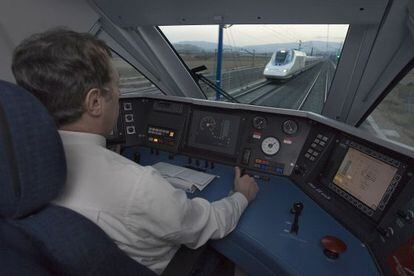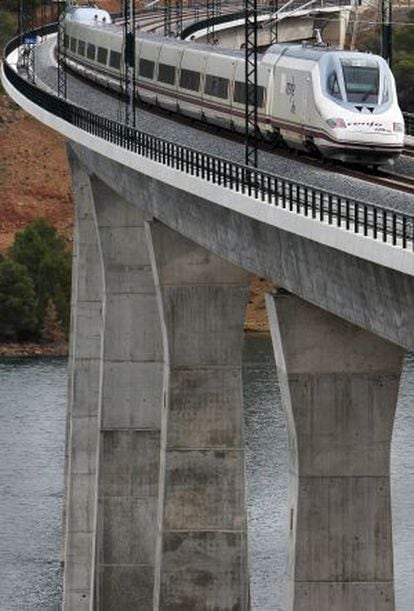Whither Spain’s high-speed trains?
Billions have been spent on building a rail network that will soon link Madrid with Paris Economists argue these prestige projects have largely proved to be loss-makers

On January 9, the day after the inauguration of the AVE high-speed railway line between Barcelona and the Catalan town of Figueres, engine drivers Manuel Niño and José Luis Herguido boarded an AVE train in Madrid. Theirs would be a historic trip: they were traveling in the first passenger train that would cross the border into France on a wide-gauge European line, ending more than 160 years of isolation and finally making it possible to travel from the Spanish capital, via Barcelona, to Paris. What the two men noticed as they traveled the 131-kilometer stretch between Figueres and the French border was that the 30 tunnels and 60 bridges they passed through and over prevented the train from coming close to reaching its top speed of 300 km/h. The line cost 3.7 billion euros, and will never make a profit, according to recent studies.
Prime Minister Mariano Rajoy will surely have enjoyed last week's jaunt between the Catalan capital and Figueres, the birthplace of Salvador Dalí. The reception the Popular Party (PP) leader received may have been cool, with so much secessionist sentiment in the air in Catalonia these days, but after all, his three predecessors have all unveiled major high-speed links. In any event, he will have another opportunity later this year when the AVE line between Albacete and Alicante is opened, completing the rapid route between Madrid and Valencia. Rajoy is due to join French President François Hollande in April to inaugurate the Paris-Barcelona-Madrid route.

Spain is in the depths of an unprecedented recession, and the government is slashing spending on all kinds of public services, yet there is no question of putting the country's high-speed rail network on hold: spending for this year will reach three billion euros.
Addressing Congress on the day of the inauguration last week, Rajoy highlighted the benefits of the AVE network, saying that the trains bring prosperity and understanding. Prosperity and uniting the nation are concepts that previous prime ministers have emphasized in relation to the AVE network, starting with the Socialist Party leader Felipe González, who oversaw the construction of the country's very first high-speed line to his home city of Seville in 1992. His successor, the PP's José María Aznar, promised that no Spaniard would live more than 30 kilometers from an AVE train.
Twenty years after the first high-speed train cut a swath through the Castilian uplands, the evidence suggests that they are simply not viable economically, or even necessary to provide rapid links between the country's cities. But no politician seems able, or willing, to put a stop to the spread of the AVE.
Over the course of the next six years, Spain intends to add 2,300 kilometers to its existing network, making it eight times that of France's and four times that of Japan - only China has a larger network.
In reality, when Rajoy and Hollande cut the ribbon in Paris sometime this spring, they will be inaugurating a line that already exists, and which came into service on January 9. Since then it has been possible to travel between Madrid and Paris on the European wide-gauge and at high speed, except for a stretch between Perpignan and Montpellier. To do so requires a brief change of train in Figueres.
In the best case scenario, it will take nine hours to get to Paris from Madrid
From the centralist perspective that has driven the development of the AVE - with Madrid as its hub - the Paris route is commercially unsustainable: in the best case scenario, from April, it will take nine hours to get to Paris, a half-hour saving on the current journey time. To get to the heart of the French capital by 4pm means boarding a train in Madrid at 6am; boarding at the more comfortable time of 1pm means arriving at 11pm. One travel writer has described the recent opening of high-speed lines as "a journey to nowhere, albeit quickly." Which is pretty much what the Madrid-Paris route will be, at least from an economic perspective.
Portugal, the final frontier
In 2003, Spain's then-Prime Minister José María Aznar met with his Portuguese counterpart, José Manuel Durão Barroso, at a summit in the Portuguese town of Figueira da Foz to announce four ambitious high-speed rail projects: Madrid-Lisbon, Porto-Vigo, Aveiro-Salamanca and Faro-Huelva. The estimated cost was 12 billion euros. But in the years that followed these plans were dropped one by one until only the 700-kilometer route between the two countries' capitals remained on the drawing board.
Aznar and Barroso kept on putting off the finishing date for the link, saying first 2011, then 2013, and then 2015. It still takes as long to travel from Madrid to Lisbon as it did 30 years ago: an overnighter aboard vintage rolling stock.
Both countries are now deep in recession. In 2009, during the Portuguese election campaign, rightwinger Manuela Ferreira Leite accused her Socialist Party rival, José Sócrates, of putting Spanish interests above those of his own country by continuing to support the rail link, which she said would be of little benefit to Portugal. The Lisbon-Madrid high-speed line, and with it the complex relations between the two countries, became the central issue in a bitterly fought campaign that Sócrates narrowly won. The Portuguese Socialist Party leader held on to the old project to link the two capital cities, ratifying it in successive summits with former premier José Luis Rodríguez Zapatero.
Then, in April 2011, Sócrates was forced to ask his EU partners for a bailout, effectively handing over his country's economic policy to the European Central Bank and the International Monetary Fund. Elections followed in June, which were won by the conservative Pedro Passos Coelho. During the campaign, he argued that the rail link should be put on hold for the foreseeable future. In March of last year, Portugal definitively laid the project to rest. The 2.7 billion euros that the country would have to invest in building its section of the link to the Spanish border at Badajoz were simply not available to a government struggling to deal with a worsening economic recession by slashing public spending. For example, this year the Portuguese government is committed to saving four billion euros, and will do so by cutting public sector wages further, sacking civil servants and freezing pensions.
Portugal still has plans to extend its rail network, but now intends to link the port of Sines (100 kilometers south of Lisbon) with Badajoz to transport goods, the aim being to boost exports. The route will also carry passengers, and trains will be able to travel at up to 200 kilometers an hour. But no completion date has been announced.
The Spanish government says that it still wants the high-speed project to go ahead. Critics say that if Portugal isn't going to complete its side of the route, there is little point in building a high-speed link to Badajoz. One of them is Barcelona Mayor Xavier Trias, who complained that Catalonia was being told to tighten its belt, while being expected to contribute toward what he called "that nonsense." The head of the regional government of Extremadura, José Antonio Morago, who backs the project, says that it will create jobs and boost his region's economy.
So far, there are no independent studies of Spain's high-speed plans that suggest they will ever be anything other than a money pit. When asked by EL PAÍS if it knew of any economist or transport and infrastructure expert who supports the investment in the AVE network, the Public Works Ministry was unable to supply a name.
Instead, the website of ADIF, the state-owned company tasked with the maintenance of the high-speed rail network, explains the benefits of the AVE. "Its benefits extend to many Spanish regions thanks to the inter-operability between the conventional and high-speed networks through technology that allows for trains with changeable gauges to use both." Fewer deaths on the road is another advantage, according to the Public Works Ministry.
The facts speak for themselves: the Madrid-Seville route attracts around 14,000 annual passengers per kilometer, more than Madrid-Barcelona, but way off the 59,000 for the train between Paris and Lyon each year, or the 51,000 on the Cologne-Frankfurt line. This is not to mention the 235,000 annual passengers per kilometer who use the Tokyo-Osaka bullet train. Just to cover its operational costs, high-speed trains need a constituency of between 6.5 million and eight million passengers a year; none of Spain's routes come close.
Spain's planners seem to have forgotten that the country has closed high-speed routes for these reasons - the Toledo-Cuenca line was used by just a few dozen passengers most of the time. There are days when nobody boards the AVE at Guadalajara or Tardienta in Huesca. Tardienta has a population of just 1,000 people, but yet it has a high-speed train station. Is this the model that will connect up Spain and make it prosperous?
Stations like this were part of the plan from the start, but nobody thought to question the logic of every Spaniard being within walking distance of a high-speed train. The dual concept of prosperity and connection has become a mantra repeated by successive governments. And yet, 20 years after the opening of the Madrid-Seville line, there is no evidence that the towns where the train stops along the way have benefited more than others. Ciudad Real's population grew by 10.9 percent between 1991 and 2001, while that of its neighboring Castilla-La Mancha provincial capital, Albacete, swelled by 14.5 percent without an AVE station during that period.
Ciudad Real saw a 32.9-percent increase in new housing, compared to Albacete's 30 percent. Córdoba, which has a station on the Madrid-Seville high-speed line, saw an increase in visitor numbers, albeit only for the first two years after the line was opened, says Daniel Albalate of Barcelona University, who has written extensively about Spain's high-speed rail network.
Germà Bel is an economist and former Socialist Party deputy in the Catalan regional parliament, as well as an expert on infrastructure. He is highly critical of Spain's transport and infrastructure policy. His 2010 book España capital París, origin y apoteosis del Estado radial (or, Spain, capital Paris, the origins and apotheosis of the radial state) has become the benchmark study on white elephants and the trend in this country to build first and think later.
You won't find a single economist who agrees with high-speed railways"
"You won't find a single economist who agrees with the investment in high-speed railways," says Albalate, adding: "It's possible that the engineering sector has been helped, although French and German companies have benefited most. We now have some knowledge and experience about managing high-speed rail routes, which is not surprising given that we have more kilometers than any other country, apart from China. But we have not generated any wealth through this enormous investment."
Spain's commitment to high-speed railways has impacted negatively on conventional rail routes, as well as the transport of goods by rail: less than four percent of all goods in Spain are carried by rail, compared to Germany's 22 percent, or the EU average of 18 percent. High-speed rails cannot be used by other trains, and are designed exclusively for carrying passengers, an approach that other countries avoided. Routes that can carry high-speed and conventional trains have a top speed of up to 250 km/h. "Opting purely for high speed has meant cutting routes in the regions. We have created a transport network for business passengers," says Albalate. In short, billions of euros have been spent to save 15 minutes on a journey time.
Spain has spent 46 billion on the new rail lines over the last two decades
Spain has spent 46 billion euros on high-speed railways over the last two decades, but the final bill will end up being much higher. Paying off the cost of Spain's ambitious public works program is growing, in much the same way that mortgage payments increase over time. It is part of the country's deficit problem, notes Albalate, who employs the following metaphor to describe the benefits of the AVE: "It is like building infrastructure in the desert."
The Barcelona-Figueres route is lined with unfinished work at stations such as the airport link to El Prat or Girona: nobody knows when they will be completed. Public Works Minister Ana Pastor said last autumn that there would be no more new AVE stations, and that the budgets for projects already underway would be revised downward.
In fact, Pastor used a new term to describe the government's policy from now on: "sustainable investment and realistic solutions," which will mean cutting the estimated 700-million-euro bill for building 24 new stations. A 12-year plan has also been announced for later this year. Could this finally be the moment that Rajoy summons up the courage to say which cities and towns will be left out of the AVE network?











































